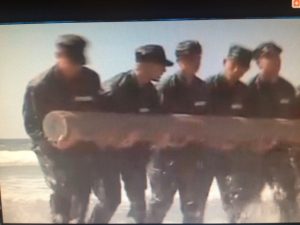So, you are thinking about Basic Underwater Demolition/SEAL training. That thought alone separates you from most people. BUD/S is where legends are forged in freezing water and suffocating sand, creating the core of Naval Special Warfare operators.
But what does it really take to succeed? You will gain valuable insights with these 10 tips for surviving Navy SEAL BUD/S training. The dropout rate is brutal, often hovering around 75 percent or higher, a figure that includes officer and enlisted seal candidates alike.
This is not an accident. The entire course of seal training is built to find your breaking point and push you far beyond it. These tips go beyond just telling you to do more push-ups; they prepare you for the real battle ahead.
Our BUD/S began with about 200, and 20 were left standing after six months. The great majority quit during the First Phase, which climaxed in the sixth week, commonly known as Hell Week.

Table of Contents:
- It Starts in Your Head, Not the Gym
- Conditioning That Matters Most
- Tactical Approaches for the Daily Grind
- Dealing with Hell Week and the Urge to Quit
- Life Beyond BUD/S
- Conclusion
It Starts in Your Head, Not the Gym
You will see incredibly fit athletes quit within the first few days of BUD/S. You will also see smaller, unassuming guys make it all the way through to graduation. The difference is not the size of their biceps; it is the unwavering strength of their mind.
1. Find Your “Why” Before Day One
You have to know, deep down, why you are there. Are you motivated by glory, money, or the allure of action movies? Those reasons will wash away with the first cold wave during Basic Underwater Demolition.
Weak motivators, like thinking about future military pay or benefits, will not sustain you. When you are shivering uncontrollably, and your muscles are screaming, you need a powerful reason to keep going. Your “why” becomes your anchor in the storm of chaos that is BUD/S.
Instructors are masters at psychological pressure and will try to break you; without a solid purpose, you will break. This internal drive is what separates those who quit from those who become Navy SEALs. It is the foundation for a successful career, not just in the service, but in any challenging job you might pursue later as a veteran.
2. Learn to Break Down the Mountain
Thinking about the entirety of BUD/S is overwhelming for even the most prepared candidates. The thought of Hell Week alone is enough to make anyone want to quit before they start. So, do not think about it that way.
Your world needs to become very small. Just focus on getting to the next meal. Then, concentrate on finishing the next evolution. After that, just make it to the next sunrise.
By breaking the impossible into tiny, achievable goals, you can keep moving forward. This is a simple mental trick that works wonders under extreme stress. You can handle anything for 10 more seconds and then 10 more after that, which is the essence of enduring the endless grind.
Conditioning That Matters Most
You obviously need to be in phenomenal physical shape. But being gym-strong is vastly different from being BUD/S-strong. The physical training is made to wear you down in very specific ways, testing a resilience far beyond what a weight room can build.
3. Master the PST, Then Exceed It
The Physical Screening Test (PST) is your ticket to the dance. Merely meeting the minimum standards for navy seal training is not good enough. You should be blowing those numbers out of the water months before you ship out to Coronado.
Arriving at BUD/S physically stressed just to keep up is a recipe for failure and injury. You want so much physical capacity in reserve that you can handle the daily beatings and still perform. The real test of military fitness starts when you are tired, and you will always be tired.
Aim for the competitive scores, not the minimums. Fitness experts in this field, like former Navy SEAL Stew Smith, consistently advise candidates to build a superior level of fitness. According to the official Navy SEAL & SWCC page, your goals should look something like this to be competitive.
| Exercise | Minimum Standard | Competitive Score |
|---|---|---|
| 500-yard swim | 12:30 | Under 9:00 |
| Push-ups (2 min) | 50 | 80-100+ |
| Sit-ups (2 min) | 50 | 80-100+ |
| Pull-ups (no time) | 10 | 15-20+ |
| 1.5-mile run | 10:30 | Under 9:30 |
This gives you a crucial buffer. When your body starts to break down from the relentless activity, your competitive performance will drop to an acceptable level. A person who started at the minimum will simply fail out of the program.
4. Get Used to Being Wet, Sandy, and Cold
This is probably one of the most vital tips you will get for surviving Basic Underwater Demolition/SEAL training. You will spend an incredible amount of time in the cold Pacific Ocean. Then, you will immediately roll around in the sand until you look like a sugar cookie, an experience unique to this training.
You cannot fully simulate this environment at home, but you can get your body and mind used to the shock. Take cold showers or ice baths. If you have access, go for a swim in a cold lake or the ocean and do your exercises right after getting out of the water.
It is about teaching your mind to function when your body is screaming at you to stop. When everyone else is panicking because of the cold, you will be able to think clearly and perform the task at hand. This acclimatization provides a huge psychological advantage and is a cornerstone of special operations conditioning.
5. Run, Then Run Some More
BUD/S involves a ton of running. You run everywhere, and much of it is done in heavy boots, with gear, on soft sand. Running on pavement is nothing like running on the beaches of Coronado, and your body needs to be ready.
Soft sand running works different stabilizing muscles and is much harder on your cardiovascular system. If you have never trained on it, it will destroy your legs, shins, and spirit. Find a beach, a park with a sand volleyball court, or even just a loose dirt trail to conduct your navy fitness runs.
Building up your “running chassis” is essential. Your joints, tendons, and bones need to be strong enough to handle thousands of footfalls a day on unforgiving surfaces. This conditioning does not happen overnight; it takes months of consistent, intelligent effort to prepare for the sheer volume of running.

Tactical Approaches for the Daily Grind
Knowing some tactical approaches to the daily grind can be the difference between standing on the grinder at graduation and ringing that infamous brass bell. It is about working smarter, not just harder. This mindset is crucial for a long career in military life.
6. Become a Team Player
The BUD/S instructors are not looking for a Rambo. They are building a SEAL Team, and the most important word there is “Team.” From day one, you will be assigned to a boat crew, and that crew becomes your new family, your lifeline.
If you see your buddy struggling under the log, help him. Carry his load for a hundred yards if you have to. You can be sure there will be a time when you need him to do the same for you, without a doubt.
The instructors manufacture situations specifically to test this. They want to see who helps their teammates and who only looks out for number one. Lone wolves get weeded out quickly, either by the instructors or by their own alienated boat crew that refuses to help them.
7. Learn How to Maintain Your Body
This is not about spa days; it is about survival maintenance. Your body is a machine, and at BUD/S, you are pushing it well past the red line every single day. Small problems, if ignored, can quickly become mission-ending failures.
Foot care is a perfect example. A small blister can become a raging, infected wound that gets you medically dropped from training. You must clean and care for your feet every single chance you get, no matter how tired you are.
Learn about basic nutrition, proper hydration, and effective stretching techniques. Use every moment of downtime, even if it is just five minutes, to stretch, eat something, or drink water. This proactive care, a key component of veteran health, will keep you in the game while others fall apart around you.
Dealing with Hell Week and the Urge to Quit
Every single candidate thinks about quitting. The ones who make it through the grueling training have learned how to manage that impulse. They have tactics and mental frameworks to get through the darkest moments of the entire special warfare pipeline.
8. Never Make a Decision to Quit at Night
Things are always worse at night. It is colder, you are more tired from the day’s events, and your mind starts to play tricks on you. The instructors know this and use the cover of darkness to apply maximum pressure.
Make a simple deal with yourself. You can quit tomorrow morning if you still feel the same way when the sun comes up. But for now, just focus on making it to sunrise with your boat crew.
Often, with the warmth of the sun and some food in your belly, things look much better. The overwhelming desire to quit usually subsides. This simple rule has saved many future Navy SEALs from ringing the bell on a bad night.
9. Find a Little Bit of Humor
This sounds impossible when you are in the thick of it. What is funny about being miserable, cold, and sandy? But finding humor in the absurdity of the situation is a powerful coping mechanism and a staple of military history.
When your boat crew is covered in mud and freezing, a single well-timed joke can break the tension and lift spirits. It reminds everyone that you are all in this ridiculous situation together. Laughing in the face of misery is a profound way of taking back a small piece of control.
It also helps bond the team. Sharing a dark laugh connects you with your buddies on a deep level, which is often discussed on military podcasts by those who have been through it. That connection makes everyone stronger and more resilient.
10. Remember that Pain Ends
The instructors will constantly tell you, “The only easy day was yesterday.” But they also might say, “It pays to be a winner.” Winning an evolution, like a boat race or a timed run, means you might get a few precious minutes of rest while the other teams keep suffering.
All the pain at BUD/S is temporary. The log sits on your head for a while, then you put it down. The cold water session ends. Even the infamous Hell Week eventually finishes, though it may not feel like it at the time.
Quitting, however, is forever. Ringing that brass bell is a final decision you can never take back. Keep that perspective in mind. The pain of the moment will pass, but the pride of earning that Trident and joining the ranks of Naval Special Warfare lasts a lifetime.
Life Beyond BUD/S
While the focus is rightly on survival, it is helpful to look at the bigger picture. Completing this training opens up a world of special operations opportunities not just in the Navy, but also respected by other branches, such as the Air Force, Marine Corps, Coast Guard, and even the Space Force.
The skills you forge—resilience, teamwork, and problem-solving under pressure—are highly sought after. Should you transition out of the service one day, this experience makes you a prime candidate for top employers. Many organizations, like the Veteran Employment Project, specifically seek out individuals with this background.
Your career advice search will be different; you will not just be looking for a job but a mission. Your resume will not need fluffy cover letters because your accomplishments will speak for themselves. The veteran employment landscape is full of vet-friendly employers who understand the value you bring.
Conclusion
There is no magic formula that guarantees success at BUD/S. It remains one of the hardest military training programs on Earth for a reason. But you can absolutely shift the odds in your favor by preparing correctly.
These 10 tips for surviving Navy SEAL BUD/S training are a good place to start your journey. True success is a battle won with mental toughness, smart physical training, and a deep, unshakable commitment to the man next to you. Your success will be documented in more than just a navy photo at graduation; it will be written into the legacy of the teams.
If you focus on these principles, you might just have what it takes to stand on that grinder at the end. You could become one of the few who earn the right to be called a United States Navy SEAL. It is a commitment to a life of service and excellence recognized worldwide.
